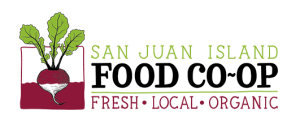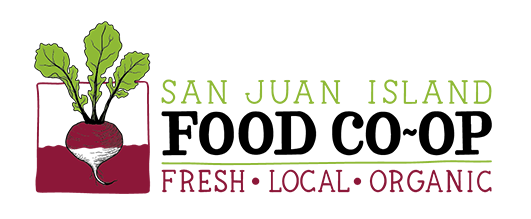The co-op is dedicated to selecting sustainably produced and wholesome foods that are organic when possible and preferably sourced locally. The local part means things that are not brought on the UNFI truck or shipped from Azure.
I find myself wondering how to make choices. Sometimes a fine local product is available but in order to get the version with the organic label it has to be shipped halfway around the world. Many people have expressed the idea that the co-op should select products that are local or regional first and U.S. or North American next, and generally avoid items that come from afar, especially if the conditions of production might be questionable. I have in the past posted a sheet near the wrapping counter along with cut off labels when possible to make source information known regarding the bulk items that are packaged in the store–usually snack items and fruits and nuts. All of those items are certified organic, but at least half of them come from very far away beyond oceans, often from places where organic inspection is not reliable. Occasionally one of these bulk items turns out to be unpleasantly stale.
As far as local items for the co-op are concerned, for the last two years I’ve made every effort to be personally acquainted with our apples in the stem and carrots in the root, our meat on the hoof and our honey in its buzz. I know my own eggs in their feather and my milk in the moo, but getting acquainted with those items brought by truck to the co-op is nearly impossible.
Last week Anna and I made an excursion to Skagit Valley to see what we could find. We visited Golden Glen Creamery in Bow-Edison, a regular old family dairy farm that offers cream-top milk in glass bottles, their own butter and cheeses, and eggs from hens that scratch in the garden behind the office. Please look at their website and consider how the co-op should think about carrying these products: http://www.goldenglencreamery.com/ I’ll have to make a longer visit to ask more questions, actually meet those cows and chickens, and taste the products before I can give any solid information. In general I think I would prefer their unhomogenized small batch pasteurized milk in glass to O.V.’s much transported and comingled product in waxed cartons. I’d choose eggs from a flock I can count over the Wilcox eggs we now carry, which, while certified organic, come from a flock of 800,000 hens in large buildings in Roy, Washington. Others will have different ideas and I’d like to hear what they have to say.
We also visited Pleasant Valley Farm and brought home pickles and kraut from right there where they were born in Laconner rather than from vegetables sourced in India. They are delicious but mass produced, without organic claims or certification. Some will disapprove; for others, local sometimes trumps organic, especially when the carbon footprint is considered.
And we visited the IGFC store and plant in Bow where our island-grown meat that is slaughtered on farm by the mobile USDA truck is butchered and packaged for us–just so I could complete the picture.
The more feedback I get the easier it is for me to decide what I should bring to the co-op and what I should pass up. Please add to this conversation and chat with me when we’re in the co-op so I can get a sense of what people want in the store.
Thanks for the input!
— Eleanor

